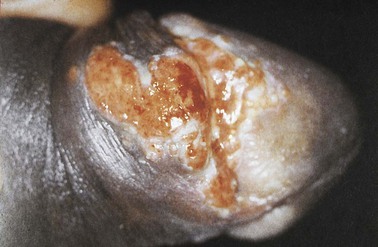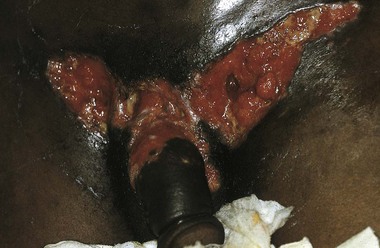Ronald C. Ballard
Klebsiella granulomatis (Donovanosis, Granuloma Inguinale)
Donovanosis is a chronic, progressive ulcerative disease, usually of the genital region, that is caused by an encapsulated, gram-negative bacterium, Klebsiella granulomatis, formerly known as Calymmatobacterium granulomatis. The infection has previously been known by other names, including granuloma inguinale tropicum, granuloma pudenda, granuloma venereum, and, most recently, granuloma inguinale. Because these names can easily be confused with that of a completely different tropical sexually transmitted disease, lymphogranuloma venereum, caused by the more invasive L-serovars of Chlamydia trachomatis, the term donovanosis has been adopted as the preferred name for the disease. The first description of donovanosis was attributed to McLeod working in India in 18811 and the discovery of the causative organism to Donovan in 1905.2
Biology of the Causative Organism
Klebsiella granulomatis is an encapsulated, pleomorphic, gram-negative bacillus, measuring 1 to 2 µm by 0.5 to 0.7 µm, that can be found in vacuoles in the cytoplasm of large mononuclear cells.3 The bacteria are frequently described as having bipolar densities that give these “Donovan bodies” the appearance of closed safety pins. The bacteria appear to multiply within these cells and are subsequently released to infect others after the rupture of mature intracytoplasmic vacuoles. The ultrastructure of the organisms has been described as characteristically gram-negative, with a clearly defined capsule and no flagella. However, small surface projections resembling pili or fimbriae have been observed, together with electron-dense granules 35 to 45 µm in diameter in the cell periphery.4 Formerly, it was thought that these granules provided evidence of bacteriophage infection; however, this remains contentious.5
Although culture of the organisms in chick embryo yolk sacs was reported in the early 1940s,6 and subsequently in egg yolk–based media7 and defined liquid media, no pure isolates were stored, and therefore none were available for study for approximately 50 years. As a result, the organisms were poorly characterized, although a relationship with Klebsiella had previously been suggested because of common morphologic characteristics. Renewed efforts to isolate Klebsiella granulomatis from clinical material have been successful using human monocyte cultures8 and Hep-2 cell monolayers,9 and so progress has been made in further characterizing the causative organisms. A detailed description of the phylogeny of C. granulomatis, based on the results of molecular studies, has been published, resulting in the name Klebsiella granulomatis comb. nov. being formally proposed.10,11
Geographic Distribution and Epidemiology
Donovanosis is a relatively rare disease in the United States, with fewer than 100 cases reported annually, although in the past, it was encountered more frequently in the southern states. However, it has been recognized as a cause of genital ulceration in parts of India, Papua New Guinea, the Caribbean, and South America (particularly Brazil) and has been recorded in Zambia, Zimbabwe, South Africa, Southeast Asia, and among Aboriginals and Torres Strait Islanders in Australia.3,12 The incidence of the disease has decreased significantly in recent years in Australia,13 Papua New Guinea,14 South Africa,15 India,16 and the Caribbean,17 either as a result of recognition of donovanosis as a public health problem, with subsequent aggressive introduction of appropriate control measures, as has occurred in Australia,13 or as a result of improvements in the provision of health services and general standards of living in areas of high endemicity. Nevertheless, cases of donovanosis may still be encountered in centers remote from these endemic regions, either as a result of immigration18 or increased vacation or business travel to these predominantly tropical areas. The disease is usually assumed to be sexually transmitted, and the possibility that it may be transmitted nonsexually remains a controversial issue. Goldberg19 has postulated that the causative organism is a commensal of the gastrointestinal tract and that the vagina may become infected by autoinoculation. Extragenital lesions and lesions in young children all indicate alternative modes of spread; however, the age distribution of the disease in endemic areas, the frequent coexistence of other sexually transmitted diseases, and the finding that the genital area is the most frequent anatomic site of donovanosis lesions all indicate that it is primarily a sexually transmitted infection, albeit of low infectivity.
Clinical Manifestations
The primary lesion of donovanosis begins as a small painless papule or indurated nodule that manifests after an incubation period of between 8 and 80 days. The lesion soon ulcerates to form an exuberant, beefy red, granulomatous ulcer with rolled edges and with a characteristic velvet-like surface that bleeds easily on contact (Fig. 237-1). Multiple lesions may coalesce to form large ulcers, and new lesions may also form as a result of autoinoculation. Characteristically, even large ulcerative lesions are painless unless there is severe secondary infection. The disease spreads subcutaneously and may become progressively more destructive (Fig. 237-2). Spontaneous healing is accompanied by scar formation, which can also produce gross deformities (Fig. 237-3). Lymphedema, with consequent elephantiasis of the external genitalia, may occur in severe cases as a result of the blockage of the lymphatics by keloid scars.20 In men, the most common sites of infection are the prepuce, coronal sulcus, and penile shaft. In women, the labia and fourchette are most commonly involved, but lesions of the vaginal wall and cervix may be an uncommon cause of vaginal bleeding. Donovanosis is frequently diagnosed during pregnancy,21 and it has been postulated that pregnancy causes exacerbation of the disease.22 However, the increase in diagnosis during pregnancy may just be a reflection of the asymptomatic nature of cervical infection and its detection on routine examination. Subcutaneous spread of granulomas into the inguinal region may result in the formation of groin swellings (pseudobubos), which are not a true adenitis.












